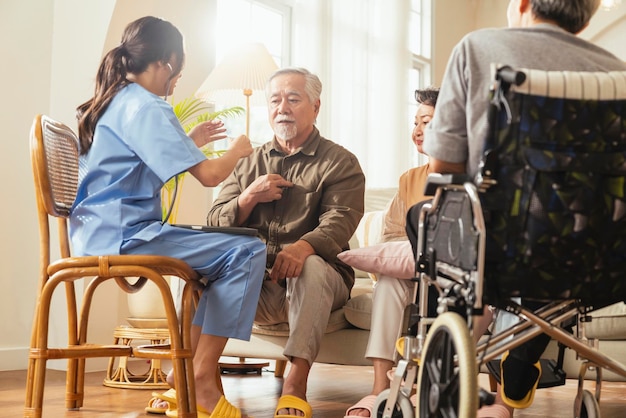Importance of Maintaining an Active Lifestyle in Later Years

Photo by Freepik
As we age, the importance of maintaining an active lifestyle becomes increasingly clear. Staying active has been shown to improve cardiovascular health, enhance mobility, reduce the risk of chronic diseases, and even boost mental health. For many seniors, the ability to continue enjoying their favorite activities—whether it’s gardening, walking on the beach, or simply spending time with family and friends—plays a crucial role in their overall well-being.
However, as seniors age, certain physical, mental, or emotional challenges can make it more difficult to remain active. That’s where in-home care in Jacksonville, FL, comes in. With the right support, seniors can continue living in the comfort of their homes while maintaining an active and independent lifestyle.
This article explores how Home Care in Jacksonville FL, provided by reputable agencies like Always Best Care, can support seniors in maintaining an active lifestyle, ensuring they enjoy their golden years with both health and happiness.
1. Understanding the Role of In-Home Care in Supporting Seniors’ Independence

Photo by Freepik
The beauty of in-home care in Jacksonville, FL, is its flexibility. Unlike institutionalized care, such as nursing homes or assisted living facilities, in-home care allows seniors to remain in the comfort of their own homes, where they are familiar with their surroundings and have easy access to their daily routines. This option enables seniors to receive the support they need to live independently without having to leave behind the environment they love.
Personalized Care Plans for Active Seniors
One of the primary reasons seniors thrive with in-home care is the personalized approach that professional caregivers provide. Each senior has unique needs, and Always Best Care in Jacksonville, FL, works closely with families to create individualized care plans that reflect their loved one’s physical, emotional, and social needs.
Care plans are designed to help seniors maintain their independence while providing the necessary assistance for daily tasks, medication management, mobility support, and more. These personalized plans allow seniors to remain as active and engaged in life as possible, without sacrificing the help they need to stay safe and healthy.
2. How In-Home Care Enhances Physical Activity for Seniors
Physical activity is one of the cornerstones of a healthy, active lifestyle, and in-home care in Jacksonville, FL, is instrumental in helping seniors stay physically active and engaged. As we age, mobility issues, balance concerns, and chronic health conditions can make it difficult to maintain regular physical activity. This is where professional caregivers step in, offering the support and encouragement necessary to keep seniors moving.
Assistance with Exercise and Physical Therapy

Photo by Freepik
Regular exercise is essential for seniors to maintain muscle strength, flexibility, and joint mobility. Caregivers from in-home care agencies in Jacksonville, FL, can help seniors with daily exercises, stretching routines, and even assist with physical therapy if needed.
For example, a caregiver might guide a senior through gentle exercises tailored to their specific needs—whether it’s light stretching for those with arthritis, walking for cardiovascular health, or balance exercises for those at risk of falls. By incorporating exercise into a senior’s daily routine, home care providers help keep seniors physically active and ensure they stay mobile as they age.
Falls are one of the leading causes of injury among seniors, and they can significantly impact an older adult’s ability to stay active. According to the Centers for Disease Control and Prevention (CDC), one in four older adults experiences a fall each year, with many suffering from injuries that lead to a decreased quality of life.
In-home care in Jacksonville, FL helps reduce the risk of falls through a combination of mobility assistance, home modifications, and fall prevention strategies. Caregivers can assist seniors with walking, transferring from bed to chair, and moving around the home safely. Additionally, caregivers help identify potential hazards within the home, such as loose rugs or dimly lit hallways, and make necessary adjustments to improve safety.
3. Social Engagement and Mental Stimulation in In-Home Care
In addition to physical health, mental and emotional health plays a significant role in a senior’s ability to live an active and fulfilling life. Social isolation and a lack of mental stimulation can lead to depression, cognitive decline, and a decreased sense of purpose. In-home care in Jacksonville, FL provides seniors with much-needed companionship, emotional support, and opportunities for mental engagement.
Reducing Loneliness and Isolation
One of the biggest challenges seniors face, especially those living alone, is loneliness. In-home care agencies help address this issue by providing caregivers who offer consistent companionship. Caregivers not only assist with daily tasks but also engage in meaningful conversations, participate in activities, and encourage seniors to stay socially active.
By spending time with seniors, caregivers help combat isolation and reduce the risk of depression, which is a common issue among older adults. Regular social interaction is key to maintaining emotional health, and having a caregiver around helps create a supportive and connected environment.
Keeping Seniors Mentally Stimulated
Mental stimulation is essential for seniors to maintain cognitive function and avoid mental decline. Home care providers engage seniors in activities that challenge their minds and keep them mentally active. For example, caregivers may encourage seniors to play memory games, solve puzzles, read books, or engage in hobbies like knitting or painting. These activities stimulate the brain, keep it sharp, and contribute to a sense of accomplishment.
Additionally, Always Best Care in Jacksonville, FL, offers personalized activities that align with each senior’s interests, helping them feel more engaged and purposeful. Whether it’s learning new skills, participating in arts and crafts, or exploring hobbies, these activities help seniors maintain cognitive function while also providing fun and enjoyment.
4. Specialized In-Home Care for Seniors with Chronic Conditions

Photo by Freepik
Many seniors live with chronic conditions, such as arthritis, diabetes, heart disease, or respiratory issues. These conditions can make staying active and maintaining independence more challenging. In-home care in Jacksonville, FL offers specialized services to help seniors manage these conditions and maintain an active lifestyle despite their health challenges.
Managing Chronic Conditions at Home
One of the benefits of in-home care is that it allows seniors to manage their chronic health conditions at home with the help of trained caregivers. Caregivers can monitor vital signs, assist with medication administration, and help seniors adhere to their prescribed treatment plans. This support ensures that seniors can manage their health and continue with daily activities without the constant need for hospital visits.
For instance, caregivers can assist seniors with mobility challenges caused by arthritis, provide wound care for those with diabetes, or support heart disease management through weight monitoring and physical activity. With personalized care, seniors are empowered to manage their conditions and stay active.
Medication Management and Health Monitoring
Seniors with chronic conditions often take multiple medications, which can be difficult to manage without assistance. Home care agencies like Always Best Care in Jacksonville, FL, provide medication management services to ensure that seniors take their medications as prescribed and avoid complications.
Caregivers can organize medications, provide reminders, and monitor for side effects. They also track health metrics like blood sugar levels, blood pressure, and weight, making sure that any health changes are noticed and addressed promptly. This proactive approach to health monitoring allows seniors to manage their conditions more effectively, supporting their ability to stay active and engaged.
5. The Role of Technology in Supporting Active Lifestyles for Seniors
In today’s digital age, technology plays an essential role in enhancing in-home care and promoting an active lifestyle for seniors. From telehealth services to smart home devices, technology helps seniors stay connected, track their health, and engage in activities more easily.
Using Smart Home Technology for Safety and Independence
Smart home technology is one of the most exciting developments in in-home care. Devices like smart speakers, fall detection sensors, and medication reminders enhance seniors’ independence and safety while allowing them to continue leading active lives.
For example, smart speakers like Amazon Alexa or Google Assistant allow seniors to easily set reminders, control household devices, and even make video calls to family members. Additionally, smart sensors can detect falls and alert caregivers or emergency services immediately, preventing serious injuries.
With the help of Always Best Care in Jacksonville, FL, seniors can enjoy a more independent lifestyle with the support of smart home devices that keep them safe and engaged.
Telehealth and Remote Monitoring for Active Seniors
Telehealth services are becoming an integral part of in-home care. With telehealth, seniors can have virtual consultations with healthcare professionals, reducing the need for in-person visits and making it easier to manage their health from home.
Remote monitoring tools also help track health metrics such as heart rate, blood sugar levels, and weight. This data is shared with healthcare providers, ensuring that seniors receive the necessary support to maintain their health while staying active.
6. How Always Best Care Supports Seniors’ Active Lifestyles in Jacksonville, FL

Photo by Freepik
Always Best Care in Jacksonville, FL, is dedicated to helping seniors maintain an active and independent lifestyle. The company offers a variety of in-home care services that are designed to support seniors in all aspects of their lives, from physical care to mental engagement.
Customizing Care Plans for an Active Lifestyle
At Always Best Care, each senior receives a personalized care plan that reflects their unique needs, preferences, and goals. The plan includes a tailored approach to promoting an active lifestyle, whether that means providing mobility support, encouraging physical activity, or fostering social engagement. Always Best Care ensures that seniors receive the exact amount of care they need to remain active, healthy, and happy.
Ensuring Comprehensive Care and Support
Always Best Care offers a holistic approach to care that goes beyond just physical support. The agency provides emotional support, companionship, and assistance with social activities, ensuring that seniors can stay engaged and connected to their communities. Whether it’s attending a local event, enjoying a hobby, or simply having a conversation, Always Best Care ensures that seniors are never isolated and always have a caregiver to help them stay involved.
7. Financial Considerations for In-Home Care Services
Cost is an important factor for families considering in-home care in Jacksonville, FL. While in-home care can be more affordable than nursing homes or assisted living facilities, it still requires careful financial planning.
Insurance and Financial Assistance
Several options can help cover the cost of in-home care:
- Medicare: Medicare may cover certain home health services, such as skilled nursing care and therapy.
- Medicaid: For seniors with limited income, Medicaid may provide coverage for home care services.
- Long-Term Care Insurance: Seniors who have purchased long-term care insurance can use it to help pay for home care services.
Families should also explore other financial options, such as veterans’ benefits or community programs that assist with the cost of care.
Supporting an Active Lifestyle for Seniors with In-Home Care in Jacksonville, FL

Photo by Freepik
In-home care in Jacksonville, FL, provides a personalized, flexible solution for seniors who want to remain active, independent, and healthy as they age. By offering tailored services that support both physical health and emotional well-being, in-home care agencies like Always Best Care enable seniors to live comfortably in their homes while enjoying a fulfilling, active lifestyle.
With the support of caregivers, smart technology, and customized care plans, seniors can maintain their quality of life, continue enjoying their favorite activities, and stay connected to their communities. In-home care truly makes aging in place a reality, helping seniors thrive in the comfort of their own homes.
FAQ Section
Q1: How does in-home care support seniors’ active lifestyles in Jacksonville, FL?
A1: In-home care provides tailored support to seniors, assisting with mobility, exercise, and health monitoring, while also offering companionship and social activities to keep them engaged.
Q2: What services are included in in-home care for seniors?
A2: Services typically include personal care (bathing, dressing), medication management, companionship, mobility support, and assistance with daily activities like cooking and cleaning.
Q3: Can in-home care help seniors with chronic conditions stay active?
A3: Yes, in-home care helps seniors manage chronic conditions by providing medication reminders, monitoring health metrics, and supporting exercise and physical therapy to maintain an active lifestyle.
Q4: How is Always Best Care in Jacksonville, FL, different from other in-home care agencies?
A4: Always Best Care offers personalized care plans that are designed to enhance seniors’ active lifestyles. The company provides a holistic approach to care, focusing on both physical and emotional well-being.


















